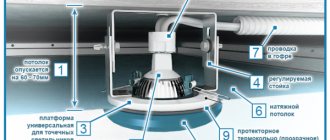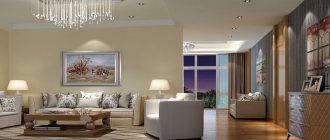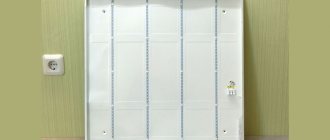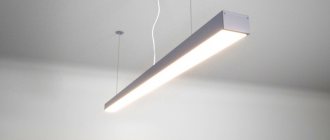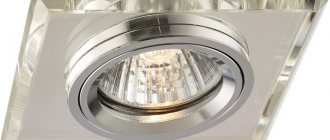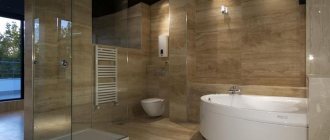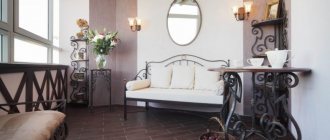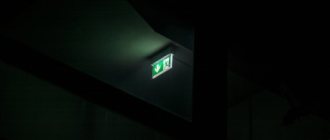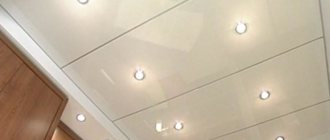Mar 06/17
The lighting market is replete with a variety of the most incredible lamp models that perform both decorative and practical functions. It is very difficult to choose just one device, because numerous chandeliers, pendants, lamps, floor lamps, etc. can be so different that you can easily make a mistake and buy something unsuitable in style and overall.
For a modern person who works a lot, not only the appearance of the lamps is important, which many buyers mistakenly pay attention to first, but also suitable lighting that will not make you sleepy or overstrain your eyes with too bright light or, conversely, dim light. Rotating spotlights, which can be ceiling or wall mounted, deserve special attention. They allow you to direct the light exactly where you need it, thereby harmoniously complementing the design of the room and making it more comfortable. “Dream House” offers its readers an overview of spot lamps. From this article you will learn how they are designed, how they are mounted, and what to consider when choosing wall and ceiling spots for different interiors.
Spot lamps in the interior
What is a spot?
It’s not for nothing that the word “spot” is quite unusual to understand, because it has English roots, and translated means “spot”. That is, a small point in the ceiling, or maybe in the wall, that gives light. Thanks to spots, you can illuminate specific parts of the room or objects in it.
The spot is designed in such a way that it has a lamp and a bracket with a rotating mechanism. Brackets for lamps can be round, arc-shaped or square. Thanks to such a bracket, ceiling spots can be rotated in any direction. Some models are equipped with a dimmer that can adjust the brightness of the light.
What are spots and their features?
Spots are specialized devices that are used to illuminate a room, highlight decorative elements and solve other individual design problems. These devices have a special design - the lamp, unlike traditional models, is not located in a fixed position, but on a specialized bracket with a hinged base. Thanks to this, the product has the ability to change the direction of lighting in accordance with design requirements.
Unlike many lighting devices, these mechanisms emit light in a fairly narrow direction and have directional light rather than scattered light. Thanks to this property, rotating ceiling spots are produced.
Models with dimmable lighting also exist and are used. This is achieved through the use of special dimmers in the product design. Their use allows not only to save energy, but also to control the brightness of lighting at night or in the morning, so that there is no feeling of excessive brightness in the eyes.
Types and differences of spots
There are several main differences by which spot lamps are distinguished. The main ones are fastening properties, lamps used and shape. Of course, don't forget about design.
According to structural characteristics, there are the following types:
- Invoices. They differ in that they do not require separately prepared holes. Installed like wall sconces. The bracket is attached to the wall, and then the lamp’s turn. Such lamps have rotating properties.
- Built-in. Such lamps cannot be rotated, but their reflector does rotate. Thanks to built-in ceiling spots, you can achieve uniform lighting throughout the room. They are installed on suspended or suspended ceilings, and a special hole is made in advance in which the lamp will be placed.
- Combined. Such spots are similar in use to chandeliers. That is, they can be installed in the center of the ceiling. Installation is similar to the spot options, only the combined spot has several lamps. They can also be directed in different directions, thereby covering all corners of the room.
For offices and large rooms, a tension lighting system is ideal, where cables are stretched and lamps can move along them.
Spots for suspended ceilings photo
Spot lamps in the interior photo
Spots rotating on a bracket
Types and varieties of spots
Ceiling spots are classified according to several parameters depending on fastening elements, lamps used, design, number of cartridges and shape.
The functionality of this device depends on the design features.
The following types of lamps :
- Built-in spots are point light sources that are equipped with a reflector rotation function. They provide uniform illumination and help create a flat surface without protruding elements. For installation, holes are made in the suspended structure where the spot is attached along with the wiring. The lamp is fixed on a special spring.
- Overhead models are convenient because separate holes are not drilled for them. Installation is reminiscent of installing a sconce. First, the bracket is attached, and then the rest of the structure. Such spots can be rotated at a selected angle and moved in the desired direction.
- Combined products are similar to chandeliers. They are mounted in the same way as spotlights, but several lamps are placed in the housing. They have functionality: they are used to illuminate both the entire room and remote corners.
- The original option is the tension system. Cables are stretched under the ceiling along which the lamps move.
Overhead and combined structures have the following fastening methods :
- string system, which is a rod or a stretched cable;
- roof rails are mechanisms made of metal or plastic;
- A common method of fastening is a flat structure of any shape: square, oval or semicircle.
When choosing a model, the type of lamps is taken into account. It is not recommended to use incandescent lamps in spots due to the thermal energy generated. This option is not suitable for tensile structures.
When decorating a room, halogen lamps , which are characterized by efficiency and durability. High efficiency of LED lamps. They do not heat up and have a long service life.
Wall and ceiling spots in the interior
Such lamps look ideal both in business office interiors and in home environments. With their help, it is possible to achieve comfortable light and at the same time add comfort to the room as a whole. Depending on the location, as well as on the type and design of the structure, spotlights can be used for different purposes:
- focusing on paintings, statues, collages;
- recreating a special pattern with light (for example, a flower, a star or the sun);
- lighting the entire room;
- illumination of the relaxation or reading area;
- zoning of rooms;
- creating a romantic atmosphere as evening light.
Rotating spots can perfectly highlight the “highlights” of rooms. At the same time, it is important that the lamp does not draw attention to itself, but is one with the interior.
In work areas, it is worth using lamps with transparent glass so that the light is most favorable for reading and does not cause vision damage. If you need to create a more romantic atmosphere or just soft diffused light, then models with frosted glass are used. For special purposes, for example, for light and music, colored glass is used.
There are more than enough models and varieties of wall and ceiling spotlights. It is always important to choose the right options for different interiors in order to hide the unnecessary and emphasize the important, in order to take care of your comfort and eye health, while making the interior only better.
Ceiling spots in the interior photo
Rotating ceiling spots for the kitchen
Ceiling spots in the living room interior
Spot lamps in kitchen design
Ceiling spots in the kitchen photo
Advantages and disadvantages of ceiling spots
Ceiling spots in the interior have many advantages, the main one of which is the ability to redirect the flow of light at any time. It is worth noting other advantages of using such lighting fixtures in the interior. These include:
- Easy to install. They are installed as easily as conventional spotlights. You can install them yourself, without having any special education or special tools.
- Visual expansion of space. Stylish lamps do not clutter up the space, and the lighting from them is no worse than from classic chandeliers.
- There is no need to lay grooves. The advantages of ceiling spots also include the ability to install them anywhere in the suspended ceiling. You don't have to lay grooves for this. It is enough to make a small hole in the ceiling through which to connect the lamp with a rigid wire.
- Versatility. Can be used for suspended ceilings and suspended structures. They are perfect for any design direction. A wide selection of rotating spots of various shapes, colors and designs will allow you to choose the optimal design in each specific case.
Other advantages of rotating spots include the ability to connect them in groups, which are controlled by separate switches.
Despite the obvious advantages of ceiling spots, they also have a number of disadvantages. These include:
- Difficulties in organizing general lighting. Using ceiling spots, it is more difficult to organize lighting, which can be achieved using a hanging classic chandelier.
- Higher cost. To obtain the required level of lighting, several lighting fixtures must be used at once, which makes their installation more expensive.
However, with the correct organization of lighting and the choice of high-quality spots, you can solve all problems with lighting in a room of any size.
What lamps can be used for spots
There are main types of lamps that are used for traditional chandeliers, but they can also be used for spot lighting.
So, incandescent lamps, to which everyone has long been accustomed, which are cheap and sold anywhere. But, alas, they are used extremely rarely for spots. Their efficiency is quite low, since they heat more air than they produce light. Actually, due to their strong heating, there is a risk of damage to the stretch ceiling by such lamps, if we are talking about built-in models.
Things are different with halogen lamps. They have high efficiency, the light is similar to sunlight. But energy consumption is quite low. Service life is about 12,000 hours.
LED bulbs are ideal for this type of lighting as they are economical and efficient. Their service life is quite long and there is no dependence on turning the light on or off. They do not heat up. For these reasons, recessed and overhead LED ceiling spots are the most popular today.
Spot design
Based on their appearance, spots can be divided into:
- Classic - with rounded lines, made of materials imitating gold, bronze or platinum.
- Modern ones are made of glass and metal, of regular geometric shape, usually rectangular or square.
- Ethnic – with national motifs and wooden elements.
Of course, the design of the spot should be in harmony with the design of the entire interior. How to properly place spots in the interior? Let's figure it out.
Depending on the purpose of the spots, they are mounted either on the walls or on the ceiling, possibly even on the floor. If you need to illuminate the entire area of the room, then complexly combined spots installed in the center will cope with this task; the streams of light can be directed in different directions, however, you will have to come to terms with the spottiness of such lighting. Another general lighting option is a series of recessed ceiling lights. The more there are, the brighter the room will be illuminated. Spots on the bar can also play this role. Several of these bars with separate switching provide light only where you need it. Energy savings are obvious. If you hang a track system in the center of the ceiling, you can create a variety of lighting scenarios.
If you need to illuminate a strictly limited area - a kitchen table, a workplace, then overhead spots or those built into furniture can be used. Spots can also illuminate the mirror area in the hallway or bathroom.
If you need to visually divide the room into zones, then ceiling spots on a rod, overhead and tension spots that can concentrate light on the desired zone are suitable.
For accent lighting, if you need to focus attention on any piece of furniture, a painting or a collection that you want to show to guests, use ceiling spots on a bar or overhead spots that direct the eye to an expressive detail of the interior.
Spots can also provide background lighting. To do this, the beam must be directed at the wall. This can be done using a recessed ceiling light. Stylish spotlights in the corners of the room also cope well with this task. Background lighting will create an atmosphere of warmth and privacy, ideal for romantic get-togethers.
If you need to create a relaxed atmosphere, try lighting the floor with built-in spots. This may be especially true for the bathroom. Spots around the perimeter and a warm floor in the center are an ideal place for relaxation.
Features of spot installation
As already mentioned, ceiling spots are for suspended ceilings, and there are for ordinary ones. In the first and second cases, the types of fastening and installation are different. But they also have a lot in common.
To install the lamp, you should complete several steps:
- Before installation, it is necessary to lay the wire to the installation site. If you have a suspended ceiling, then this is done out of sight; if it is ordinary, then the wire is laid in the wall. That is, installation is carried out in the same way as in the case of conventional chandeliers.
- The connection is made according to a parallel connection scheme: first the connection device, then the first device, then each subsequent one.
- As with any other lamps, the amount of electrical cable should be purchased with a margin of about 25-35 cm.
- After the ceilings are installed or wires are laid to the necessary points, the luminaires themselves are installed.
Installation of ceiling spotlights
How to install rotating spots on the ceiling
Types of lamps
Spots in the living room come in different types depending on the type of mounting.
Ceiling lamps
Used as an additional light source or can completely replace central lighting. The advantage of this option is the ability to change the direction of light, which allows you to illuminate certain objects, while other interior elements remain dark. For example, you can allocate a workplace or a relaxation area. These designs are small in size, which allows them to be used in low rooms.
Wall models
Such spots are not only an additional source of light, but also perform a decorative function, as they are equipped with attractive lighting. Such designs can be placed near paintings or above a coffee table. If you choose the right power, the product can serve as a night light.
Built-in
This type is installed on the ceiling in the same way as recessed ceiling lights. They are installed using insert springs.
On a note! The use of different glasses will allow you to set the required lighting brightness. Glass with a frosted coating creates soft and uniform lighting, and with the help of transparent glass you can set directional and spot light.
Such models do not eat up space and practically do not stand out if they are installed on a suspended or suspended ceiling structure.
Invoices
The spots of the overhead device fit tightly to the ceiling, which does not allow them to change the direction of the light flux. Their external characteristics do not differ from other models.
Rod mounting
This option has several lighting fixtures located on a flat or curved strip. Some models are mounted on a flexible rod, which allows them to take any position. Spots can become an excellent alternative to the main light source or act as decorative lighting.
Bracket-mounted structures
One of the popular and widespread types, which provides maximum freedom in choosing the direction of the light. The design may have one or more reflectors. The open mount has different shapes, which allows you to create a single system that will look original and catchy.
